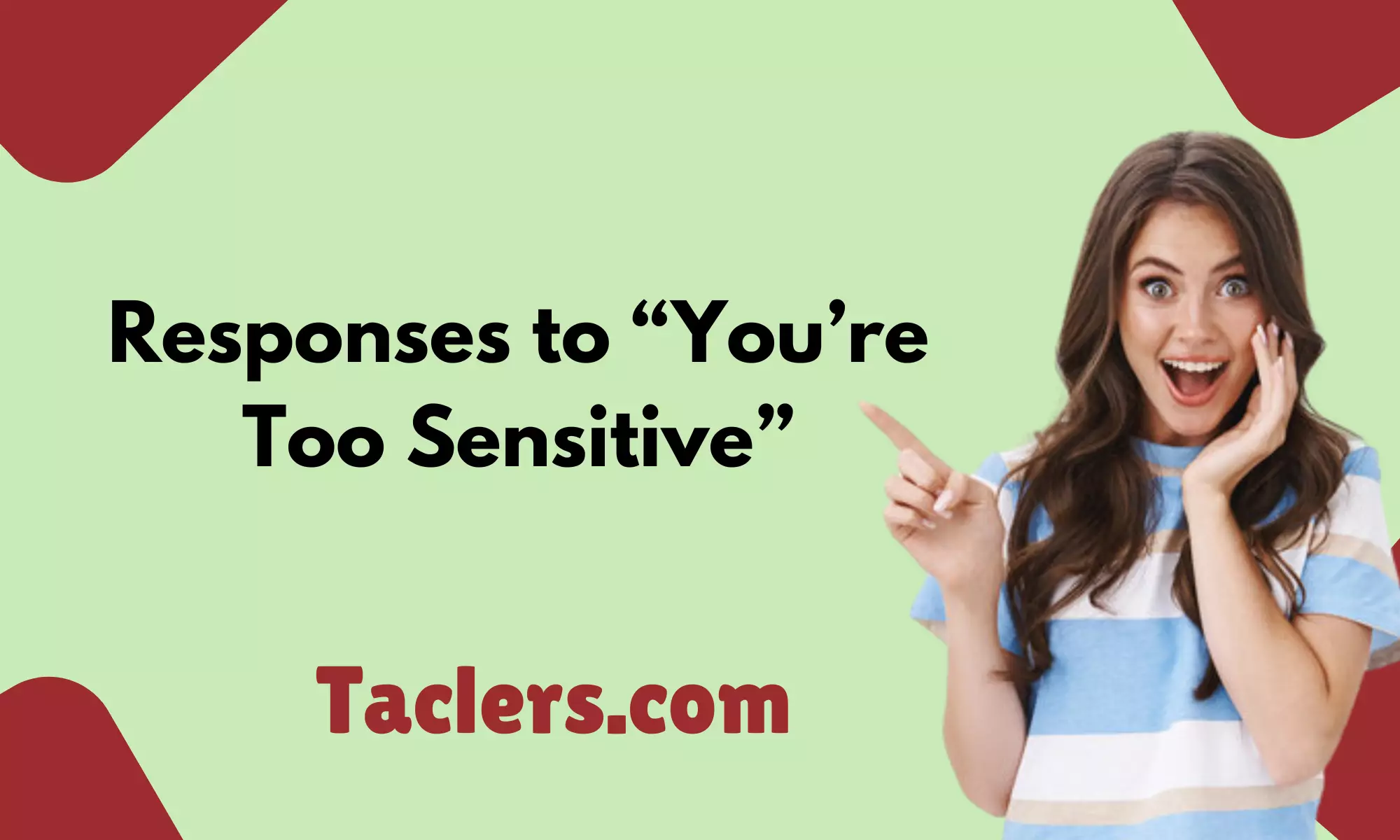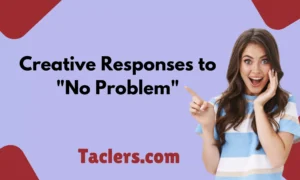Being told “You’re too sensitive” can be disheartening, especially when you feel your emotions are valid. Responding effectively in such situations requires a balance of assertiveness and composure.
Here are 28 thoughtful responses to address the comment “You’re too sensitive,” tailored to maintain your dignity and promote understanding.
1. “I’m simply expressing my feelings honestly.”
Explanation:
This response asserts your right to express emotions while maintaining honesty.
Example:
Person A: “You’re too sensitive.”
Person B: “I’m simply expressing my feelings honestly.”
By saying “Expressing my feelings honestly,” you highlight the validity of your emotions.
2. “I value open communication and that’s why I’m sharing this.”
Explanation:
This reply emphasizes the importance of communication in addressing concerns.
Example:
Person A: “You’re too sensitive.”
Person B: “I value open communication and that’s why I’m sharing this.”
By saying “Value open communication,” you underscore your commitment to discussing issues.
3. “I appreciate your feedback, but my feelings are valid to me.”
Explanation:
This response acknowledges the other person’s perspective while affirming the legitimacy of your feelings.
Example:
Person A: “You’re too sensitive.”
Person B: “I appreciate your feedback, but my feelings are valid to me.”
By saying “My feelings are valid to me,” you reinforce the importance of personal emotions.
4. “Can we discuss why my sensitivity is an issue?”
Explanation:
This reply invites a deeper conversation about the reasons behind the comment.
Example:
Person A: “You’re too sensitive.”
Person B: “Can we discuss why my sensitivity is an issue?”
By saying “Discuss why my sensitivity is an issue,” you seek clarity and understanding.
5. “My sensitivity is part of who I am, and I’m working on managing it.”
Explanation:
This response acknowledges your sensitivity while showing a proactive approach to managing it.
Example:
Person A: “You’re too sensitive.”
Person B: “My sensitivity is part of who I am, and I’m working on managing it.”
By saying “Part of who I am,” you embrace your emotional nature while indicating personal growth.
6. “I’m expressing how I feel, which is important for me.”
Explanation:
This reply underscores the importance of sharing your emotions.
Example:
Person A: “You’re too sensitive.”
Person B: “I’m expressing how I feel, which is important for me.”
By saying “Important for me,” you highlight the necessity of your emotional expression.
7. “Sensitivity is not a flaw; it’s how I process things.”
Explanation:
This response reframes sensitivity as a natural part of your emotional processing.
Example:
Person A: “You’re too sensitive.”
Person B: “Sensitivity is not a flaw; it’s how I process things.”
By saying “Not a flaw,” you challenge the negative connotation of sensitivity.
8. “Let’s focus on the issue rather than my emotional response.”
Explanation:
This reply redirects the focus to the underlying issue rather than your sensitivity.
Example:
Person A: “You’re too sensitive.”
Person B: “Let’s focus on the issue rather than my emotional response.”
By saying “Focus on the issue,” you aim to address the root cause of the problem.
9. “My feelings are a reflection of my experiences; can we talk about it?”
Explanation:
This response invites a discussion about the experiences influencing your emotions.
Example:
Person A: “You’re too sensitive.”
Person B: “My feelings are a reflection of my experiences; can we talk about it?”
By saying “Reflection of my experiences,” you provide context for your sensitivity.
10. “I understand that you might not see it that way, but my feelings are real to me.”
Explanation:
This reply acknowledges differing perspectives while validating your own feelings.
Example:
Person A: “You’re too sensitive.”
Person B: “I understand that you might not see it that way, but my feelings are real to me.”
By saying “Real to me,” you affirm the legitimacy of your emotions.
11. “It’s important for me to express my feelings; can we address the matter at hand?”
Explanation:
This response highlights the significance of expressing feelings while focusing on resolving the issue.
Example:
Person A: “You’re too sensitive.”
Person B: “It’s important for me to express my feelings; can we address the matter at hand?”
By saying “Address the matter at hand,” you aim to resolve the underlying issue.
12. “I’m open to feedback, but it’s also important to respect my emotions.”
Explanation:
This reply indicates openness to feedback while emphasizing respect for your feelings.
Example:
Person A: “You’re too sensitive.”
Person B: “I’m open to feedback, but it’s also important to respect my emotions.”
By saying “Respect my emotions,” you seek acknowledgment of your feelings.
13. “Can we explore why my sensitivity is affecting this discussion?”
Explanation:
This response invites a deeper exploration of how your sensitivity impacts the conversation.
Example:
Person A: “You’re too sensitive.”
Person B: “Can we explore why my sensitivity is affecting this discussion?”
By saying “Explore why my sensitivity,” you aim to understand its impact on the conversation.
14. “I’m sensitive because I care deeply; can we discuss this further?”
Explanation:
This reply frames sensitivity as a sign of care and invites further discussion.
Example:
Person A: “You’re too sensitive.”
Person B: “I’m sensitive because I care deeply; can we discuss this further?”
By saying “Care deeply,” you connect sensitivity with your level of concern.
15. “Let’s work together to address my concerns rather than labeling them.”
Explanation:
This response encourages collaboration to resolve concerns rather than dismissing them.
Example:
Person A: “You’re too sensitive.”
Person B: “Let’s work together to address my concerns rather than labeling them.”
By saying “Address my concerns,” you promote cooperative problem-solving.
16. “I’m sharing my perspective; it’s important for us to understand each other.”
Explanation:
This reply emphasizes the importance of mutual understanding in communication.
Example:
Person A: “You’re too sensitive.”
Person B: “I’m sharing my perspective; it’s important for us to understand each other.”
By saying “Understand each other,” you highlight the need for empathy.
17. “My emotional responses are valid; let’s focus on resolving the issue.”
Explanation:
This response validates your emotions while steering the conversation towards resolution.
Example:
Person A: “You’re too sensitive.”
Person B: “My emotional responses are valid; let’s focus on resolving the issue.”
By saying “Valid,” you affirm the legitimacy of your feelings.
18. “It’s important to address both the issue and my feelings about it.”
Explanation:
This reply underscores the need to consider both the issue and your emotional response.
Example:
Person A: “You’re too sensitive.”
Person B: “It’s important to address both the issue and my feelings about it.”
By saying “Both the issue and my feelings,” you advocate for comprehensive resolution.
19. “My sensitivity is a part of who I am; can we discuss how it impacts our interactions?”
Explanation:
This response frames sensitivity as a personal trait and invites discussion on its impact.
Example:
Person A: “You’re too sensitive.”
Person B: “My sensitivity is a part of who I am; can we discuss how it impacts our interactions?”
By saying “Part of who I am,” you emphasize the personal nature of your sensitivity.
20. “I appreciate your input, but my emotions are valid and deserve respect.”
Explanation:
This reply acknowledges the other person’s perspective while asserting the need for respect.
Example:
Person A: “You’re too sensitive.”
Person B: “I appreciate your input, but my emotions are valid and deserve respect.”
By saying “Deserve respect,” you emphasize the need for consideration of your feelings.
21. “I’m trying to be open about my emotions; can we work on understanding each other better?”
Explanation:
This response promotes openness and mutual understanding in addressing emotional concerns.
Example:
Person A: “You’re too sensitive.”
Person B: “I’m trying to be open about my emotions; can we work on understanding each other better?”
By saying “Understanding each other better,” you seek improved communication.
22. “Let’s address the issue directly rather than focusing on my emotional response.”
Explanation:
This reply redirects attention to resolving the issue rather than discussing your sensitivity.
Example:
Person A: “You’re too sensitive.”
Person B: “Let’s address the issue directly rather than focusing on my emotional response.”
By saying “Address the issue directly,” you aim to resolve the core problem.
23. “My sensitivity allows me to connect more deeply; can we discuss this?”
Explanation:
This response frames sensitivity as a positive trait that fosters deeper connections.
Example:
Person A: “You’re too sensitive.”
Person B: “My sensitivity allows me to connect more deeply; can we discuss this?”
By saying “Connect more deeply,” you highlight the benefits of sensitivity.
24. “I’m expressing my feelings because they matter to me; let’s focus on the issue.”
Explanation:
This reply underscores the significance of your feelings while focusing on the issue at hand.
Example:
Person A: “You’re too sensitive.”
Person B: “I’m expressing my feelings because they matter to me; let’s focus on the issue.”
By saying “Matter to me,” you affirm the importance of your emotions.
25. “I’m open to discussing my sensitivity if it helps resolve the issue.”
Explanation:
This response shows willingness to address sensitivity if it aids in solving the problem.
Example:
Person A: “You’re too sensitive.”
Person B: “I’m open to discussing my sensitivity if it helps resolve the issue.”
By saying “Helps resolve the issue,” you demonstrate flexibility and focus.
26. “Sensitivity is a part of my personality; can we work on finding a solution?”
Explanation:
This reply acknowledges sensitivity as a personality trait and seeks collaborative problem-solving.
Example:
Person A: “You’re too sensitive.”
Person B: “Sensitivity is a part of my personality; can we work on finding a solution?”
By saying “Part of my personality,” you frame sensitivity as a personal trait.
27. “I’m sharing my emotions because they are important to me; let’s discuss the matter at hand.”
Explanation:
This response highlights the importance of your emotions and redirects focus to the issue.
Example:
Person A: “You’re too sensitive.”
Person B: “I’m sharing my emotions because they are important to me; let’s discuss the matter at hand.”
By saying “Important to me,” you assert the significance of your feelings.
28. “I appreciate your perspective, but my feelings are valid and deserve to be heard.”
Explanation:
This reply acknowledges the other person’s viewpoint while affirming the validity of your emotions.
Example:
Person A: “You’re too sensitive.”
Person B: “I appreciate your perspective, but my feelings are valid and deserve to be heard.”
By saying “Deserve to be heard,” you emphasize the need for emotional validation.

Ethan Richards, a distinguished writer at Taclers.com, excels in blending sharp insights with engaging storytelling. His background in sociology adds depth to his analysis of human reactions, making his articles both thought-provoking and entertaining. Explore the world of reactions with Ethan and see familiar moments in a whole new light.










